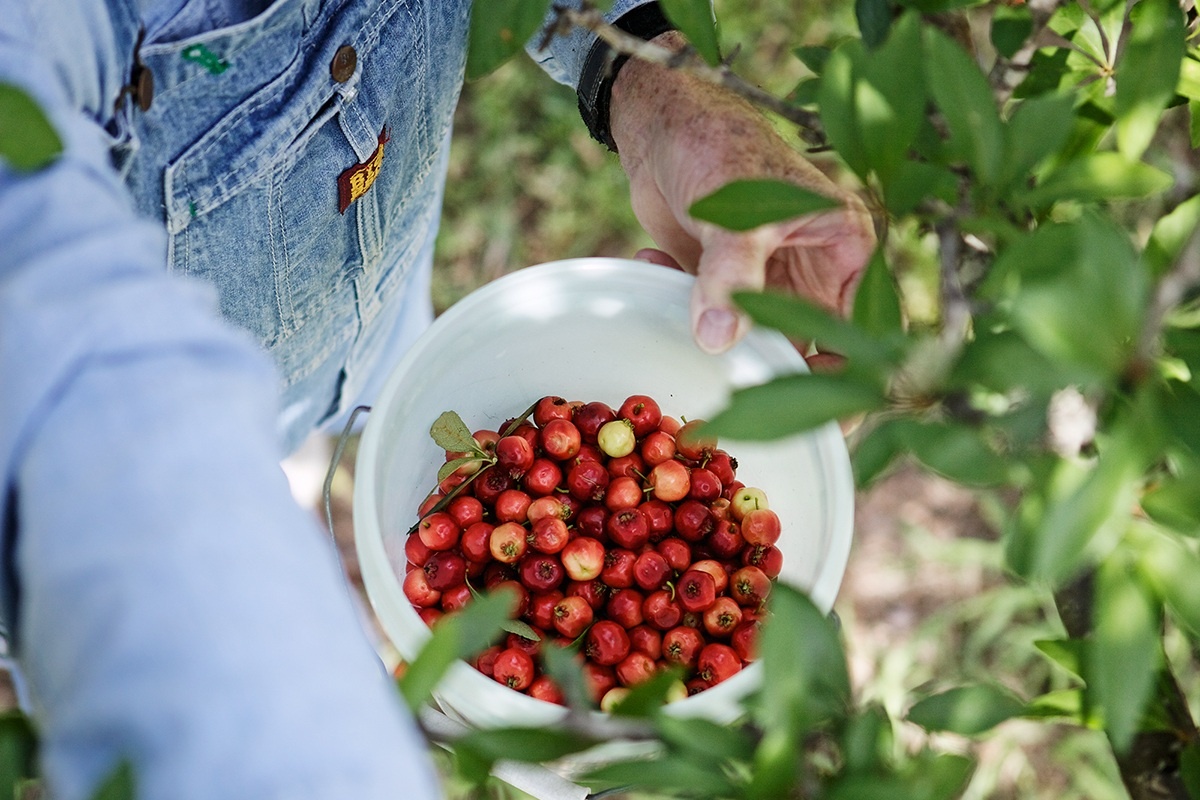Until recently, fruit from the mayhaw tree wasn’t something you grew; it was something you found—and getting to it in the wild rarely was easy.
Finding edible plants in the backwoods and backyards of Texas is a specialty of Mark Vorderbruggen, author of Idiot’s Guide: Foraging. He knows exactly where to find mayhaw.
“East Texas,” he says. “In East Texas, they can be found along the Trinity River, the river bottoms, in the low swampy areas.” Mayhaw also grows wild in swampy and woodsy areas of Louisiana and Georgia.
Demand for the regional fruit is growing just as its natural habitat is shrinking. Mayhaw never has been easily accessible, and with deforestation, land development and disease, the population of wild trees has shrunk while demand for the fruit is on the rise.
Mayhaw, a member of the hawthorn family, blooms in late spring, and its berries typically ripen in May. The plants are about 8–10 feet tall, and the white flowers give way to bright red and sometimes yellow fruit less than an inch across. These days, the plants are grown commercially and are available from nurseries to be planted in orchards and gardens.
The fruit, pucker-inducing and jewel-like, becomes flavorful when married with sugar. Raw, it’s similar in flavor and texture to crab apples, and good for you—high in vitamin C and beta-carotene.
“It’s a little tart and somewhat acidic,” Vorderbruggen says.
Historically, families sought out the fruit and made jelly from it as a welcome addition to the fruits and vegetables they grew.
The mayhaw fruit’s tartness makes juice that’s perfect for jelly and syrup. For appreciative Southerners, mayhaw jelly on a hot, buttered biscuit holds a special place. The taste is wildly fruity, like apple jelly with a little kick.
Jelly is the tasty reward for venturing into the wet, swampy and boggy areas where wild mayhaws prosper, even when their root structure is completely submerged. The tree is frequently found nestled among water-loving hardwood trees such as cypress, where it is shielded from full sun. Collecting the fruit almost always includes skimming the ripe berries from the water, where they float. Using nets, buckets and boats, foraging families scoop up the fruit then head home to extract the juice.
Now that mayhaw jelly is recognized as a Southern delicacy, a 12-ounce jar fetches up to $20 online. Some local hardware stores and farmers markets offer the jelly, and even more mayhaw goods can be found at the annual Hull-Daisetta Mayhaw Festival held every spring in Liberty County.
Still, mayhaw lovers have been looking for new ways to get their berries, and a handful of agriculture programs around the country have stepped in to develop tree varieties that can be cultivated in a traditional orchard setting.
Mayhaw is adaptable. The trees grow wild in poorly drained soil but also can grow well in drier conditions. Grower Jackie Merket of Beckville, a member of Rusk County Electric Cooperative who lives southeast of Longview, has found the tree to be quite drought-tolerant. Merket is among a handful of mayhaw growers who are successfully harvesting mayhaw fruits, and even he is amused by his success.
“I’m from West Texas. I didn’t even know what a mayhaw was,” he says with a laugh.
A neighbor introduced the species to him, and once he had the jelly, he thought he’d try growing it himself. He has been so successful, he can’t keep up with demand. Because the fruit is difficult to find and even more difficult to harvest on a large scale, jelly makers with an expanding market are turning toward commercial growers, including Merket.
“My biggest customer is a jelly maker out of Arkansas,” he says.
Commercial growers are up against the same time constraints that foragers face: a short season with berries that must be harvested quickly. The berries continually ripen over the course of a week, requiring multiple harvests. At room temperature, they are good for only a day or two after picking but freeze wonderfully. Freezing the berries helps harvesters extract the juice that is the building block for sweet treats. Merket usually gets his berries into the freezer within four hours to ensure quality.
Jelly might be what mayhaw is best known for, but once the juice is extracted, it can be fermented into wine or added to cakes and ice cream.
“There is a guy out of Arkansas who has been making ice cream for several years,” Merket says. “It’s very good, and they approached Blue Bell one time about making some, [but] there was no way they could supply enough mayhaws to even do a one-day run.
“That is the biggest problem: We just don’t have enough growers right now.”
——————–
LaDawn Fletcher is a Houston-area writer who enjoys writing about Texas.


